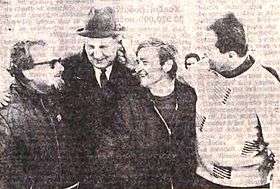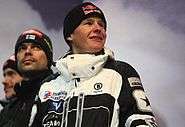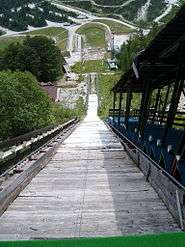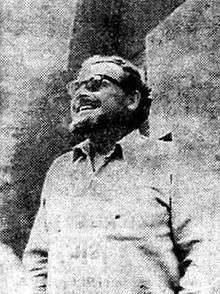Letalnica bratov Gorišek
| Letalnica bratov Gorišek | |
|---|---|
 | |
| Constructor(s) |
Janez Gorišek (planning) Vlado Gorišek (realization) |
| Location | Planica, Slovenia |
| Operator | ZŠRS Planica |
| Opened |
6 March 1969 (test) 21 March 1969 (official) |
| Renovated |
1979, 1985, 1994, 2000, 2003, 2005, 2010, 2013/15 |
| Closed | 2014 |
| Size | |
| K–point | 200 m |
| Hill size | 225 m |
| Longest jump (unofficial / fall) |
252 m (827 ft)* (16 March 2016) |
| Official hill record |
248.5 m (815 ft) (20 March 2015) |
| Top events | |
| Ski Flying World Championships | 1972, 1979, 1985, 1994, 2004, 2010, 2020 |
| World Cup |
1987, 1991, 1994, 1997, 1999, 2000, 2001, 2002, 2003, 2005, 2006, 2007, 2008, 2009, 2011, 2012, 2013, 2015, 2016 |
Letalnica bratov Gorišek (English: Flying hill of Gorišek brothers) is a ski flying hill located in Planica, Slovenia, built in 1969. The hill is named after the original constructors and brothers Vlado (alias "Lado") and Janez Gorišek. With total of 28 world records set it is the world leading ski jump hill in this statistics. They installed the world's steepest zip-line with average incline at 38.33% (20.9°) and maximum incline at 58.7% (30.5°) incline which is opened since 19 September 2015.[1]
It's the biggest of totally eight hills at Planica Nordic Centre.[2] Yugoslavian ski jumper Miro Oman was honoured to make a premiere 135 m (443 ft) long jump on 6 March 1969 at hill test. The first ever FIS Ski Flying World Championships was organized on this hill in 1972. After Matti Nykänen set world record 191 meters at SFWC 1985, new rule by FIS was accepted where no points for jumps over this distance was awarded in order to prevent world record hunting. On 17 March 1994 Andreas Goldberger touched the snow with his hand at 202 m and made first ever over two hundred meters jump, but it was invalid. Just a few minutes later Toni Nieminen landed on his feet at 203 m and officially became the first man in history who jumped over two hundred meters. On this hill, man for the first time jumped over 160 m, 170 m, 180 m, 190 m, 200 m, 210 m, 220 m and 230 m. The hill will host the FIS Ski Flying World Championships in 2020.[3]
History
1967–1968: Construction

Velikanka bratov Gorišek (original name) was planned, constructed and developed by Slovenian constructors, engineers and brothers Vlado and Janez Gorišek. At the time leading engineer of Planica was a Bloudek's succeedor Stano Pelan, who proposed to enlarge Bloudkova velikanka but at the end they rather decided for totally new hill on another location.
At that time Janez Gorišek was working as an engineer in Libya where he actually draw a plan and profile for new hill called Velikanka bratov Gorišek. Construction started in summer of 1967 and was mainly completed in late 1968. During the construction Janez was still working in Africa and that's why his older brother Vlado Gorišek (more known as "Lado") was fully in charge of the construction site. Brothers communicated on the phone but they mostly exchanged long letters. Original calculation point was at K153, steepest landing zone part at 42°, inrun was 145 meters long and height difference between take-off table and bottom of the hill was 127 meters.
1969: Opening
In February 1969 they built a complete new judge tower at 100 meters mark, which was 12 meters high and 8 meters wide. On 6 March 1969 hill was first time tested and Miro Oman from Yugoslavia was honored to be the first man to jump on the hill. He jumped 135 meters from the second gate and set the first hill record.[4]
Hill was officially opened and took three days competition from 21–23 March 1969 called KOP Ski Flying Week or Planica Ski Flying Week. There were 60 jumpers from 15 countries. Three days of competition with three jumps each day: 1 best jump from Friday competition and two best jumps from each Saturday and Sunday counted for final result.
Jiří Raška was the winner where a total of 90,000 people has gathered in the three days of competition. World record was improved five times and finally stopped at 165 meters set by Manfred Wolf from East Germany.



.jpg)
.jpg)

.jpg)

1972: First ski flying world championships
First ever FIS Ski Flying World Championships 1972 was organized in Planica. Swiss ski jumper Walter Steiner became the first ski flying world champion. Calculation point was changed to K165.
1974: Three egrets logo
Egret as the symbol of ski flying and official logo of Planica was designed by Bine Rogelj and Angelo Oman in 1974 to honour the 40th anniversary of international ski jumping in this famous valley. Slovene ski jumper and painter Bine Rogelj at first had a plan to engrave "image of an Egret flying" on a tombstone of another famous Slovene ski jumper Janez Polda. Slovene architects Angelo Oman and Rogelj together made a final decision of a new logo with three egrets flying in swarming formation.[5]
KOP Ski Flying Week or. Planica Ski Flying Week 1974 event was organized for the second time with calculation point at K165. The winner was Swiss ski jumper Walter Steiner who jumped 169 m (544 ft) and tied the world record from Oberstdorf set in a previous year by East German ski jumper Heinz Wossipiwo. Walter Steiner jumped even 177 m (581 ft) but he touched the ground with his hands.
1977: Last ski flying week
KOP Ski Flying Week or. Planica Ski Flying Week 1977 was organized for the third and the last time in Planica with calculation point at K165. Reinhold Bachler win the event with new hill record of 172 m (564 ft) and set the new hill.
Yugoslavian/Slovenian ski jumper Bogdan Norčič became first man in history to overjump 180 metres mark but unfortunately record didn't count. As a test jumper he touched the ground with his hands at 181 m (594 ft).
1979: Second world championships
The FIS Ski Flying World Championships 1979 was organized in Planica for the second time and for the fifth time in total with new calculation point at K185. Hill Austrian ski jumper Armin Kogler became the world champion. East German ski jumper Klaus Ostwald tied the world record at 176 m (577 ft).
1984: 50th anniversary renovation
In the honor of Planica's 50th anniversary organizing committee decided to modernize the hill. First big renovation works were done in summer and fall of 1984. Soldiers from Yugoslavian army, volunteers and different working organizations helped at the conbstruction site under command of Gorišek brothers. 1500 m cubic meters of material was dug out and filled it into the landing zone. They also dug out 300 cubic meters of material from inrun. Old wooden inrun tower was replaced with steel and take-off table was pushed back for 5 metres.
1985: Nykänen's 191 m and new rule
Planica for the third time hosted FIS Ski Flying World Championships 1985. On the official training three new world records were set. First Mike Holland with 186 m and soon after Matti Nykänen with 187 m and 191 m. This last Nykänen's world record scared and confused FIS so much that in the next season new unreasonable rule in ski flying was introduced. It meant that points for jumps longer than 191 meters won't be calculated in the final score and this way stop world record race. On the first day of competition there was a record attendance of about 80-100 thousand people. Ski flying world champion became Matti Nykänen.
1987: First World Cup and last parallel record
For the first time two World Cup ski flying individual events were organized on this hill in 1987. Polish ski jumper Piotr Fijas set the last parallel style world record on the first day of competition when he jumped 194 m (636 ft). But this world record was recognized seven years later at FIS congress in Rio de Janeiro when they cancelled this controversial 191 meters rule.
Next event on this hill were two World Cup ski flying individual events in 1991. German ski jumper André Kiesewetter touched the ground at the world record distance 196 m (643 ft). This is the longest ever parallel style jump although it's invalid.
1994: First over 200 metres ever
Competition counted both as FIS Ski Flying World Championships 1994 and for the World Cup points at the same time. At the first round of the free training on 17 March 1994 Austrian ski jumper Andreas Goldberger touched the snow with his hand at 202 m and made first ever over two hundred meters jump, but it was invalid. Just a few minutes later Finnish ski jumper Toni Nieminen landed on his feet at 203 m and officially became the first man in history who jumped over two hundred meters. The last world record of this year was set on the next day in qualifying round when Norwegian ski jumper Espen Bredesen landed at 209 m (686 ft).
Two days competition rules at that time counted separately each day with two rounds for World Cup points and total result of both days with four rounds as ski flying world championships title. However, first day of competition was cancelled because of the strong wind. Second day of competition with now total of two rounds counted as Ski Flying World Championships and World Cup event. Czech ski jumper Jaroslav Sakala (189 m, 185 m) became world champion. Norgegian ski jumper Espen Bredesen (178 m, 182 m) was second and Italian ski jumper Roberto Cecon (160 m, 199 m). at press conference right after the medal ceremony Espen Bredesen gave his silver medal in the spirit of fairplay to Roberto Cecon and took his bronze medal instead. Although official results didn't change, he thought it was the right thing to do, because of that crazy rule, they counted Cecon's points only up to 191 meters although he jumped 199 meters in the last round.
This was the last ski flying competition under those rules. Just two months later it was cancelled at FIS congress in Rio de Janeiro in 1994.
1997: Peterka frenzy, German fairplay
Two World Cup individual events were organized for season finale in 1997. Everyone in Slovenia expected from very young and unexperienced Slovenian ski jumper Primož Peterka, who was at the time extremely popular in his homeland, he will become a first Slovenian with World Cup overall title. TV ratings in Slovenia that weekend were and still are record high and everyone was watching. A record 130,000 people in total has gathered in those three days of competition.
Primož Peterka fall at qualifying round and injured himself but didn't have his own physiotherapist. That's why his coach kindly asked German physiotherapist from his main rival Dieter Thoma to help Peterka by this injury. In the spirit of fairplay he helped him and he could normally compete for overall title in the next two days. In the first day of competition world record was two times improved (210m, 212 m) in the trial round. Peterka was fourth in the first event and became the overall winner in front of 70,000 frenzy people and Thoma's hopes ended. German ski jumper Dieter Thoma fell at world record distance of 213 m (698 ft). When Peterka lifted overall globe, huge crowd of fanatic people jumped over the fences and ran under the medal ceremony stage.
1999: Two world records
Three World Cup individual events were organized for season final in 1999. In the first day of competition German ski jumper Martin Schmitt fell at world record distance of 219 m (719 ft) but very soon in the next round, he stood on the feet and set the new world record at 214.5 m (704 ft). On the next day Norwegian ski jumper Tommy Ingebrigtsen improved world record at 219.5 m (720 ft).
2000: First ever ski flying team event
For the first time in history ski flying team was organized for season final in 2000. Two world records were set by Austrian ski jumpers Thomas Hörl with 224.5 m and Andreas Goldberger with 225 m.[6] Germany became the first ever team ski flying winner.
2003: Hautamäki dominated
Two World Cup individual and one team events were organized for season final in 2003. Polish ski jumper Adam Małysz at first equaled Andreas Goldberger's world record at 225 m (738 ft). Then Finnish ski jumper Matti Hautamäki set series of three world records (227.5 m, 228.5m and 231 m) who won all three, including team, events. Finnish ski jumper Veli-Matti Lindström fell at world record distance of 232.5 m (763 ft).
2004: Hill was renamed
In honour of FIS Ski Flying World Championships in 2004 hill was modified and renamed and not to be confused with the legendary Bloudkova velikanka, a large hill just a few meters away. The literal translation of Velikanka (gigantic, extra large hill), meanwhile literal translation of the flying hill. For the first time in history of FIS Ski Flying World Championships team event was organized.
2005: Outstanding final round
Two World Cup individual events were organized for season final in 2005. It all started on 17 March 2005 on training when Austrian ski jumper Andreas Widhölzl fell at world record distance of 234.5 m (769 ft).[7]
Last day of the season was just fantastic with four official and one invalid world records and unbelievable final round. It started in trial round when Norwegian ski jumpers Tommy Ingebrigtsen euqaled world record at 231 m (731 ft) and soon after him Bjørn Einar Romøren set new world record at 234.5 m (769 ft).[8][9] It continued in the final round where we have seen series of jumps over 220 and 230 meters. In the final round Finnish ski jumper Matti Hautamäki for the fourth time in his career improved the world record at 235.5 m (773 ft) but that didn't last long.[10] Just three minutes later Bjørn Einar Romøren again set the world record 239 m (784 ft) which lasted for six years.[11] As the last jumper on the top Finnish ski jumper Janne Ahonen had a hard crash on his back at world record distance of 240 m (787 ft).[12] Years later Ahonen released his autobiography where he confessed that he was drunk during this record jump with fall.
2010: Ammann dominated
Planica got new chairlift, judge tower renovated, landing zone widened, profile adjusted and take-off angle lowered to keep jumpers closer to the ground. All this was needed to fulfill international FIS standards and to keep the competition.
For the record sixth time Planica hosted FIS Ski Flying World Championships 2010. In two day four series event, Swiss ski jumper Simon Ammann became individual ski flying world champion.[13] In two series Austria became team event world champion. Fifty-five thousand people has gathered on the second day of individual competition and eighty-two thousand people in whole week.
2015: Complete renovation
The hill was completely renovated and opened after one-year break. A new profile was drawn by Janez Gorišek with the help of his son Sebastjan Gorišek who is a constructor too. The hill's new calculation point is at K200, hill size at HS 225 and with new height difference at 135 meters. Inrun tower and take-off table are made of concrete. Take-off table is now 5 meter higher than before and pushed back for 12 meters compared to the old one.
Two World Cup individual and one team events were organized for the season final in 2015. Slovenian team won both individual and team events. Prevc set new hill record at 248.5 metres.[14][15]
2016: Kasai 500th, Prevc, records
Because of Peter Prevc's successful season and huge interest, tickets were immediately sold out. As always, TV signal was produced by RTV Slovenia with 19 cameras for international broadcasting and additional four cameras for Slovenian TV viewers only.
On 16 March 2016 twenty-seven fore ski jumpers from three countries tested the hill in two series. The same as the previous year, Rožle Žagar was honoured with the opening jump. Later, Tilen Bartol fell at 252 metres (827 ft).[16][17][18] On 17 March 2016 Japanese ski jumper Noriaki Kasai celebrated his 500th individual World Cup start in Planica.[19] Prevc won two individual events and broke world cup records for most points overall, most individual wins and most podiums in one season.[20][21] Robert Kranjec was winner of another individual event. Norway won the team event.
A total of 111,000 people (2,500 / 20,500 / 22,500 / 32,500 / 33,000) has gathered at hill test and four days of competitions at the season final in Planica, including the Slovenian president Borut Pahor.[22][23][24]
Events
Hill record
Official
|
Invalid
*hill/world records with fall, touch or glide. |
Other records
- On 17 March 1994 Austrian ski jumper Andreas Goldberger touched the ground at 202 m and became the first man ever in history who jumped over two hundred, but jump was invalid because he touched the ground with his hands.
- On 17 March 1994 Finnish ski jumper Toni Nieminen landed on his feet at 203 m and officially became the first man in history who jumped over two hundred.
- Firs ever jump over 160 m, 170 m, 180 m, 190 m, 200 m, 210 m, 220 m and 230 m was set on this hill but didn't always necessary standing on the feet.
- between 80,000-100,000 people gathered on first day of SFWC 1985 competition, biggest ever crowd in this competition and Planica.
- On 22 March 1997 has gathered 70,000 people which is the biggest FIS Ski Jumping World Cup single event crowd ever.
- The first ever FIS Ski Flying World Championships was organized on this hill in 1972.
- On 18 March 2000 first ever FIS Ski Flying World Cup Team event was organized.
- 33 individual FIS Ski Flying World Cup events were organized.
- 10 team FIS Ski Flying World Cup events were organized.
- 6 FIS Ski Flying World Championships were organized.
- 12 invalid world records (fall, touch or. glide) were set.
- 28 official world records were set on this hill.
Technical data
- K-point – 200 m
- hillsize – 225 m
- inrun angle – 35.1°
- inrun length – 133.8 m
- takeoff table height – 2.93 m
- landing zone angle – 30.6° to 35.6°
- takeoff table to bottom height – 135 m
In popular culture
In 1974, the Letalnica bratov Gorišek appeared as the main location in The Great Ecstasy of Woodcarver Steiner, a German film directed by Werner Herzog which portrayed Swiss ski jumper Walter Steiner who works as a carpenter for his full-time occupation.[27]
In 1997, the landscape painting of the flying hill, drawn by Vinko Bogataj, appeared at the end of the footage on the American ABC's Wide World of Sports show presented by Brent Musburger. Clip shows an interview with Vinko Bogataj about his agony of defeat.[28]
In 2014, an image of the flying hill was portrayed at the American The Queen Latifah Show hosted by Queen Latifah. Image was used in the background at the parody sketch "Norwegian Sven Nordquist, the oldest ski jumper in Sochi".[29]
See also
References
- ↑ "planica zipline". planica-zipline.si. Retrieved 14 March 2016.
- ↑ "The New Planica Nordic Centre". slovenia.si. Retrieved 20 February 2016.
- ↑ A.G. (9 June 2016). "Planici SP v poletih, ne pa tudi v nordijskih disciplinah" (in Slovenian). RTV Slovenija. Retrieved 10 June 2016.
- ↑ "New world record this year in Planica?" (PDF) (in Slovenian). dolenjski list. Retrieved 19 March 2015.
- ↑ "Posters of Planica by Guček". slideshare.net. Retrieved 30 Mar 2015.
- ↑ "Thomas Hoerl set world record". mopo. Retrieved 13 March 2016.
- ↑ "Andreas Widhoelzl crashed at 234.5 m WR in Planica 2005". youtube. Retrieved 11 March 2015.
- ↑ "Tommy Ingebrigtsen tied WR at 231 m in Planica 2005". youtube. Retrieved 14 July 2009.
- ↑ "Bjoern Einar Romoeren set new WR at 234.5m in Planica 2005". youtube. Retrieved 20 March 2015.
- ↑ "Matti Hautamäki set new world record at 235.5 m in Planica 2005". youtube. Retrieved 6 March 2009.
- ↑ "Björn Einar Romören set new world record at 239m in Planica 2005". youtube. Retrieved 7 January 2008.
- ↑ "Ahonen crashed at world record 234.5 m in Planica 2005". youtube. Retrieved 1 January 2010.
- ↑ "All four jumps of Simon Ammann for ski flying world champion title at Planica 2010". ORF. Retrieved 22 February 2011.
- ↑ "Peter Prevc set hill record at 248.5 m in Planica 2015". youtube. Retrieved 20 March 2015.
- ↑ "Planica: Prevc Wins With Record Jump and Targeting Overall Win". sloveniatimes. Retrieved 20 March 2015.
- ↑ "Tilen Bartol crashed at WR 252m in Planica 2016 as test jumper ORF". ORF. Retrieved 16 March 2016.
- ↑ R. K., T. J. (16 March 2016). "Kakšen začetek! Prišlič 246 m, Bartol 252 m s padcem" [What a start! Prislic with 246 metres and Bartol fell at 252 metres] (in Slovenian). RTV Slovenija. Retrieved 16 March 2016.
- ↑ "Complete results from Planica hill test 2016". sloski.si. Retrieved 16 March 2016.
- ↑ "Japan's Kasai marks 500th appearance at Ski Jumping World Cup". Kyodo News. Retrieved 17 March 2016.
- ↑ "Prevc claims season record World Cup win in Planica". dpa. Retrieved 17 March 2016.
- ↑ "By winning in Planica Prevc broke two more records". RTV Slovenia. 17 March 2016.
- ↑ D. S. (20 March 2016). "Foto: Planica kraljica - pod Poncami izjemnih 111 tisoč gledalcev" [Queen Planica - outstanding 111,000 spectators] (in Slovenian). RTV Slovenija. Retrieved 20 March 2016.
- ↑ T.O. (20 March 2016). "V sliki in besedi: 33.000 gledalcev uživalo v zadnjem planiškem dnevu" [In pictures and words: 33.000 spectators enjoyed in the last Planica day] (in Slovenian). RTV Slovenija. Retrieved 20 March 2016.
- ↑ STA, Spletno uredništvo (20 March 2016). "FOTO: Prevc, Kranjec. Dvojna slovenska zmaga v Planici" [Prevc, Kranjec. Double Slovenian victory in Planica] (in Slovenian). Večer. Retrieved 20 March 2016.
- ↑ "Iz 24UR: Velikanka čaka letalce" (in Slovenian). POP TV. Retrieved 16 March 2015.
- ↑ "Svetovna velikanka čaka le še na skakalce" (in Slovenian). RTV Slovenija. Retrieved 16 March 2015.
- ↑ "The Great Ecstasy of the Woodcarver Steiner - Werner Herzog". Werner Herzog Filmproduktion. Retrieved 26 Jan 2012.
- ↑ "Vinko Bogataj interview and his landscape painting of the flying hill shown at the end of the footage". ABC. Retrieved 30 Mar 2015.
- ↑ "Photo of the flying hill in the background of the comedy sketch of The Queen Latifah Show". The Queen Latifah Show. Retrieved 2 Mar 2014.
External links
| Wikimedia Commons has media related to Letalnica bratov Gorišek. |
- Official website planica.info
- Planica Nordic Centre nc-planica.si
Coordinates: 46°28′35″N 13°43′16″E / 46.47639°N 13.72111°E
.jpg)
